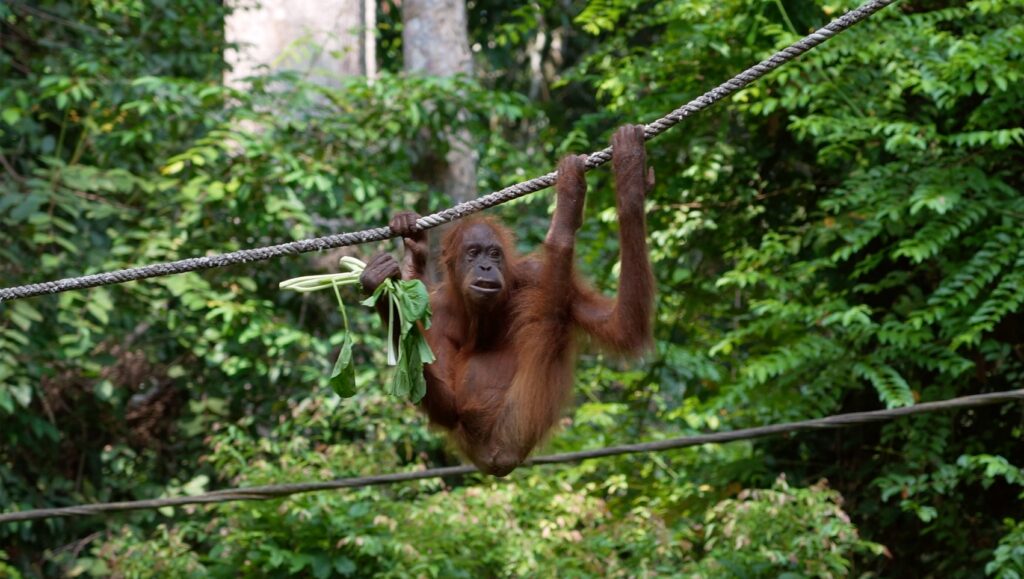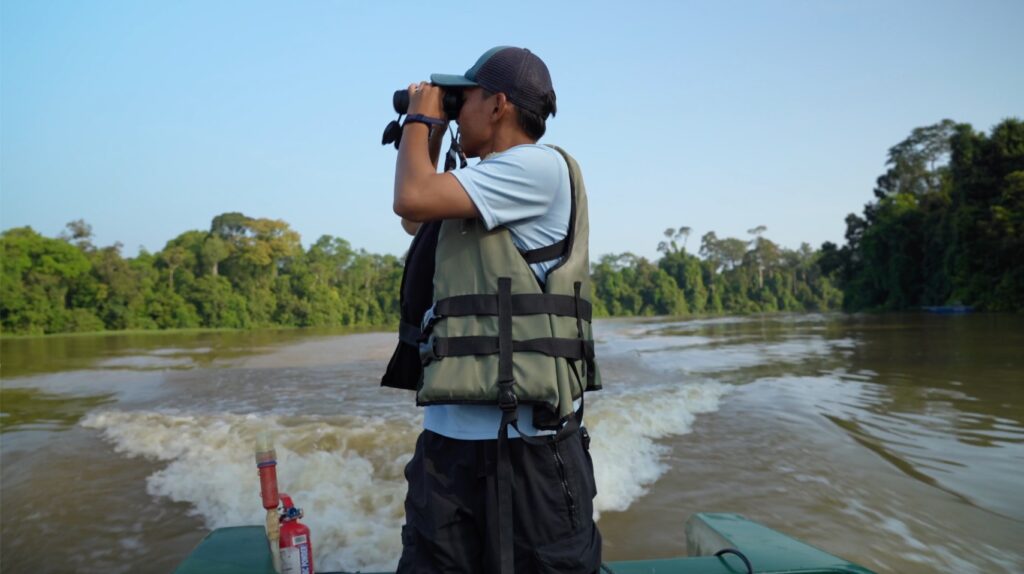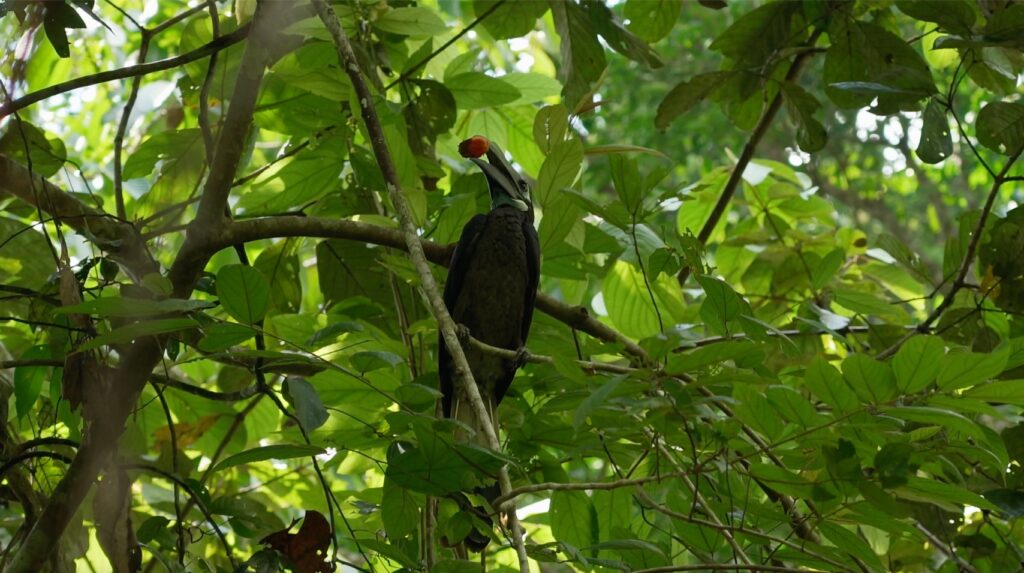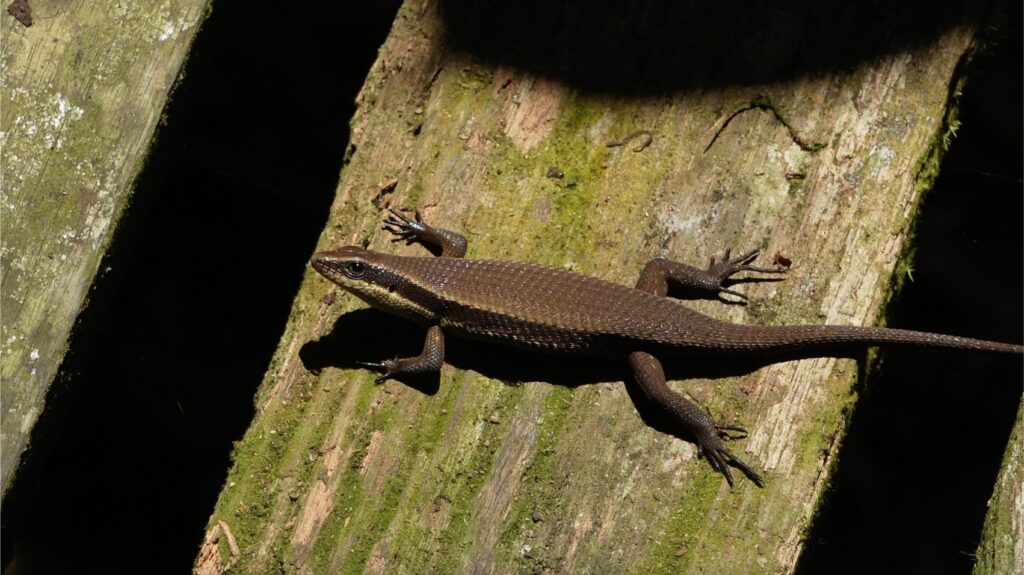Even though we have been traveling for well over two years now, I still find myself in unbelievable situations about to do something that I had previously only dreamed of. This trip to Borneo was definitely one of those situations. I have always had a love and fascination for the great apes. Growing up, and even as an adult, I read every library book I could get my hands on and watched numerous documentaries to learn more about the great apes. Jane Goodall is my hero! I was fortunate enough to get to do a Mountain Gorilla trek in Uganda a few years ago, which remains one of the most amazing wildlife experiences I have ever had. Now, here I was in Borneo about to go into the rainforest jungle in search of wild Orangutans.
Even though I had been in Borneo over ten days, I still couldn’t believe that I was actually being presented with the opportunity to see Orangutans in the wild. I don’t have the words to describe my excitement as I found myself on the Kinabatangan River in the tropical rainforest of Borneo on a wildlife adventure. The two cities we had visited first, Kota Kinabalu and Sandakan, quickly faded from my mind as we boarded the boat to head upriver where we would stay at a jungle lodge. Accessible only by boat, the Sukau Rainforest Lodge is for people that want to go into the jungle and see the wildlife of Borneo.

Before setting off for the lodge, our first stop was at the Pusat Pemuliharaan Sepilok Orang Utan Sanctuary. This 10,000 acre sanctuary opened in 1964 as the logging and palm oil industries were causing drastic decreases in Orangutan and other animal populations then, over sixty years ago. There are three Orang Utan sanctuaries in Borneo all focusing on the preservation of the type of Orang Utan found in Borneo, the Pongo Pygmaeus, which there are less than 30,000 left. There is also the Sumatran Orang Utan found in Sumatra, with only 13,000 left. And the Tapanuli Orang Utan found only in the Tapanuli district of Sumatra with only 800 left.

Orangutan is actually two Malay words. Orang meaning person, and Utan meaning forest. So Orangutan literally means person of the forest. In the wild, Orangutans are naturally solitary creatures, only coming together to mate or establish territory. They also would rarely, if ever, come down to the ground. But now, through loss of habitat, or having to be raised in a sanctuary with many others, their natural patterns are changing. Where a solitary mother would raise and teach her baby for around seven or eight years, and if she was lucky, still only have two or three babies in her lifetime. Now orphaned babies are raised together and stay together in the forest after leaving the sanctuary.


We did not get to see the babies in the nursery as they are very susceptible to human disease. We were able to see the adolescents playing and learning how to do things for themselves. We also got to observe one of the two daily feeding times. During these periods, Macaque monkeys come in from the jungle to try and get in on the action, and also some Orangutans that have been returned to the wild. They are allowed to wander in and get a meal if needed. We were told that these animals are fed the exact same thing every day to try to encourage them to go into the forest and look for a larger variety of food on their own. On this particular morning, a young mother Orangutan with a tiny baby, came in to supplement her diet. Then, much to everyone’s surprise, a big 21 year old male came in.

He had been raised at the sanctuary but had been returned to the wild many years ago. They said he shows up every now and again to get his fill of bananas and green beans. He was so interesting and handsome with his big facial flanges, I could have watched him all day. He was so big! But he could definitely swing his big body through the trees at top speed with those long muscular arms.
After touring the sanctuary, it was time to set off for the Sukau Rainforest Lodge. Like a kid on Christmas morning, I was almost dizzy with anticipation as I boarded the boat to head up the Kinabatangan River. Even after all the exciting travels I have experienced, I still could not quite believe that I was heading into the rainforest to look for wild Orangutans!


We arrived at the lodge after going about an hour and a half upriver. The boat ride was awesome. I saw a couple of tiny villages right after we started up the river, but soon there were no other villages and very few other boats. There were two other lodges before we reached Sukau. The lodge was more upscale than I was expecting. Built in a beautiful log cabin design, the lodge had great food and two swimming pools. Still, it is not a resort style vacation destination or for the feint of heart. It is for wildlife viewing expeditions that keep you on a pretty strict schedule. There was also a National Geographic birding expedition staying there. The bird life there is tremendous and just added to the experience.





After arriving at the lodge and putting our things in our room, we set off on a four hour river expedition. There were only six of us the boat plus our guide, Farhan. We had the same guide from our pick-up point all the way through to our drop off point at the end. He was great. He could spot things in the jungle that amazed us. Talk about eagle eyes, this young man has them! He didn’t just stick to the main river either.


He took our boat down tributaries and small waterways overgrown with jungle. The scenery was like something out of a movie. The green river, the thick rainforest jungle, the heavy smell of greenery and blooming flowers, and especially all the sounds. The noise of the insects, the calls of many different birds, the chattering of monkeys, and an occasional splash as something big churns in the water, all the sounds of adventure! It was magical.



We were at the lodge for three nights. Every day started off with a three hour river expedition at 6:00 am. We would have another one that started at 2:00 pm and lasted until sunset. We were free to do whatever we wanted between 11:00 am and 2:00 pm.

There were also night time expeditions that took place from 8:00 to 10:30 pm. We did one the first night and spotted a lot of wildlife! But it seemed so rude, all these poor creatures being woken up by a glaring spotlight. We turned off down a small river tributary and that’s where we encountered the jumping snake. He jumps from bush to bush, luckily he didn’t jump from his bush into our boat. Then some type of fierce Hornet started buzzing around the boat driver and he was afraid of them. He said they were attracted to his light, so he turned it off. When the spotlight went off, it was pitch black. I couldn’t see my hand in front of my face, or any of the other people in the boat.


The overhanging trees blocked any light from the moon and stars. But the driver just kept the light off and started the boat back up. I have to say I was more than a little apprehensive. How did he know where he was going? The river has random rocks sticking up and floating logs and things that are easy to see in the daylight, including large crocodiles. He would occasionally turn the light back on just long enough to check out the water, then snap it back off. I like a good adventure, but did not want to find myself floating in a pitch black jungle river waiting to be rescued. I’ve been on several night safaris in Africa, but doing one on the river added a whole different element of excitement!

I saw so much wildlife on our daily expeditions. Found only in Borneo the Proboscis Monkeys were wild to look at. The males are much bigger than the females and have the big droopy nose that covers much of their lower face, and big pot bellies. The females had long pointy noses. There are several species of monkeys that swim, but the Proboscis is adapted for swimming. Living along the riverbanks, they have webbed hands and feet that allow them to out swim Crocodiles, which is their main threat, after man.



Even though we saw quite a few troops of them, in actuality there are only a few thousand left. I also saw the pretty Silver Leaf Monkey, or Silver Langur along with the Maroon Langur, both found only in Borneo. They have sweet little faces and their coloring ranges from a light orange to a deep maroon, so pretty. They almost look like a stuffed animal. There were two types of Macaques, the long tail and the short tail. Squirrels of all sizes, and a particularly pretty jet black squirrel.

The bird life here is amazing. I was first introduced to the Hornbill in Africa and found them amazing and delightful. They have eight types of Giant Hornbills here, and I got to see all of them but one. The most majestic is the Rhinoceros Hornbill. These giant birds are found only in parts of Southeast Asia. In addition to being huge and beautiful, they have a large colorful horn, called a casque, on top of their big bills. They are very intelligent, mate for life, and live up to 35 years. They live in hollow trees where the male will seal the female up while she incubates and hatches their eggs. Once the chicks start getting feathers, the male and female work to chip away the dried mud that held them in. The male feeds her and the chicks through a small opening the entire time, so they definitely have a relationship built on trust. If something happens to the male during this time, the female and chicks will die. Because of loss of habitat, they are on the threatened list. Since they only have one or two chicks every few years, this makes it even harder for them to maintain their numbers.

I also saw the Oriental Pied Hornbill, the Asian Black Hornbill, the Bushy Crested Hornbill, the Wrinkled Hornbill, the White Crowned Hornbill, and the Wreathed Hornbill. All are spectacular to look at. The one I didn’t get to see was the Helmeted Hornbill. Their numbers have plummeted to the brink of extinction. All of these animals were amazing to see, and I feel so lucky that I got to see them. But the one I specifically came here to see had yet to turn up, a wild Orangutan.




During our free time on the second full day at Sukau, we decided to go exploring the jungle paths that lead out from behind the lodge. There are several long wooden walkways that extend out into the rainforest. If you want to go exploring off the walkway, you need to be prepared with long pants, boots, and gaiters to keep the leeches off. We decided to stick to the wooden walkway. Not having much hope of seeing any big animals in the heat of the day, we had settled in to watching all the tiny life going on around our feet. The jungle insects are also amazing!


Then, a troop of long-tailed Macaques started to move in. Our guide had told us that often times a troop of Macaques travel nearby Orangutans. He also told us that if we were not in a big group, we should not hang around long when the Macaques moved in. They can be very aggressive and are known as “The Jungle Mafia”. But we weren’t very hopeful about seeing an Orangutan because we had seen quite a few Macaques coming and going close to the lodge since our arrival. A small male Macaque moved in, and then some mothers with tiny babies, and some playful adolescents. We were watching them play and eat fruit when we heard a big branch break.

We started looking up into the tall trees and I found my heart beating faster and I was holding my breath. Then there they were, three Orangutans! We could only catch glimpses of their red orange hair at first. Then two of them settled in one high up spot and the third, an adolescent was having his playtime. We watched him swinging from tree to tree, back and forth, barely stopping long enough for us to get a good look.


Then he grabbed a vine and started swinging on it. He grabbed it with his feet, let go with his hands, and slid down to about 20 feet above the ground. He really put on a show with his play and he was only about 30 feet away from us. Then he came down to where he was only 10 feet off the ground. He hung upside down, and performed all kinds of antics. He was watching us watch him, and he did not seem bothered by us. We were told that if we came close to an Orangutan, to just act normal, and don’t start whispering as they would take the change in your voice as a threat and move away.

We were able to observe him for a good half hour. Then Aaron said we need to move out. I turned around and we were being surrounded by the Macaques. There were now several large males and they were showing their long canine teeth and hissing. The younger ones started mock charging us. I know Macaque monkeys may not sound scary, but when there are about 60 of them surrounding you and closing in, it does feel threatening as their teeth are much longer and sharper than a dogs.
I hated to stop watching the Orangutans, but I also know how lucky I was to get to spend this much time so close to a wild one. So I counted this as a wonderful blessing and we slowly backed down the walkway. Needless to say this was the highlight of the Borneo jungle adventure for me!


On our last afternoon expedition, Farhan told us that some of the rare Pygmy Elephants had been spotted earlier, but they were pretty far up the river and if we wanted to see them we would have to go at top speed to see if we could spot them. There are only 300 of these small elephants left in the wild so we said “Yes, let’s go”. It was an amazing boat ride and Farhan went down many tributaries near where the elephants had been sighted, but we did not find them. We had gone so far up the river that it was well after dark by the time we made it back to the lodge. Even though we did not find the elephants, it was still amazing as we did spot so many birds coming in to roost and bats going out. Not to mention all the other wildlife settling in for the evening. To make it even better, it was only Aaron and I in the boat with Farhan. The others in our group had not stayed as many nights as us so we had the boat and guide all to ourselves.


The next morning we boarded a larger boat to head back to Sandakan. The Captain took us back down the river to the ocean, and we headed towards Sandakan. We had one last stop at the Sepilok Rainforest Discovery Center. Originally built as a research center for scientists to observe the rainforest canopy, this series of towers with suspension bridges give you a breathtaking view of the jungle forest. We saw a lot of species of monkeys and birds here, and where Orangutans had built some nests for sleeping. In addition to tourists coming, it is also used to educate school children on how wonderful and fragile the biodiversity of their country is, and how to take care of it so it doesn’t disappear.


Our Borneo adventure turned out to be way more than I ever dreamed it would be. I still am in awe of the wonderful adventure I had every time I think about it. I feel so lucky and blessed to have seen so much wildlife. But the icing on the cake was seeing wild Orangutans! It’s an experience I will never forget. Now I have seen wild Mountain Gorillas and wild Orangutans. Next on the list is wild Chimpanzees, wild Bonobos, and wild Lowland Gorillas.
Check Out Our Wild Orangutan Adventure Video


